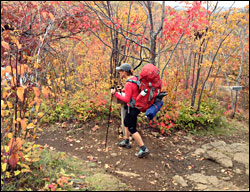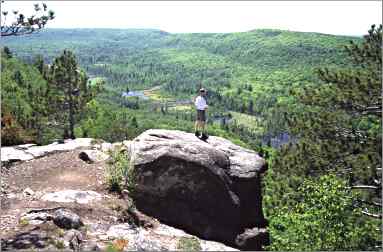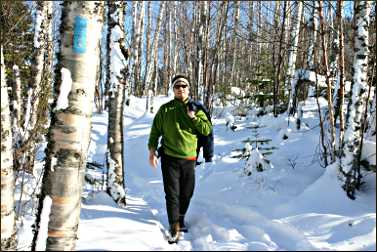Trekking the Superior Hiking Trail
You can backpack, day hike, stay in lodges or go with a group on Minnesota's premier path.

© Beth Gauper
To a novice, Minnesota's Superior Hiking Trail presents a bewilderment of possibilities.
There are 310 miles of trail between Jay Cooke State Park near Duluth and the Canadian border. Some are in the city, some deep in forest. Many stretches include spectacular views of Lake Superior, but others (gasp!) are a little boring.
People come from all over the nation to hike this beloved trail, and some take three or four weeks and do the whole thing. But there are many ways to hike the trail.
You can fit in a couple of the most popular day hikes on a trip to the North Shore, or you can spend a weekend backpacking. You can walk a loop, pay for a shuttle or shuttle yourself by car or bicycle.
You can spend as much as you want, too — from $349 per day to stay in a lodge on a guided trip to $35 per day to backpack with a non-profit outdoors club.
Here's how to plan your trip on the Superior Hiking Trail.
Gathering information
You may want to buy a copy of the Trail Atlas, $24.99, and the Superior Hiking Trail Databook, $11.95.
If you're planning more than a few day hikes, spend $35 to join the Superior Hiking Trail Association, whose volunteers maintain the trail.
If you're planning to backpack, join the Superior Hiking Trail Facebook group, whose members post invaluable advice about gear, campsites, mileage and itineraries. They're also gracious about answering questions.
What to know
Allow an hour for each 1½ miles, or 1 mile with a backpack. Even day hikers should bring water and snacks, wear sturdy shoes and be prepared for sudden weather changes.
Be sure to treat your skin and/or clothes for ticks, especially in spring and summer. Disease-carrying deer ticks are not uncommon along the North Shore. For more, see How to prevent Lyme disease.

© Torsten Muller
Before heading out, check the Trail Conditions page of the Superior Hiking Trail website. In spring, bridges may be out and the trail very muddy. In late summer, water may be low in streams.
In 2024, the popular Bean and Bear Lakes loop from Silver Bay will close May 15 for maintenance and the eastern side of the Split Rock River loop will close Sept. 1. Hikers will be able to bypass the closed sections.
In fall, hunters are out, and when the deer firearm season starts the first Saturday of November, the Lake County part of the trail closes. In winter, trailheads may not be plowed.
Use extreme care around the rivers. Furious currents can drown swimmers, especially in the Temperance River.
Bears rarely are seen on the trail, but most hikers put their food in canisters or trees, which also helps protect it from rodents, a more likely threat.
For help finding your way to trailheads and landmarks, see North Shore by the mile.
Choosing a hike
Spur hikes start right off Minnesota 61, many in the state parks — especially Gooseberry Falls, Tettegouche, Temperance River and Cascade River.
There aren't many loops, but the five-mile loop up and down the Split Rock River, four miles east of Gooseberry Falls State Park, is very popular.
The trail association describes trail sections. For a short backpacking trip, it recommends the 11-mile stretch between Silver Bay and Minnesota 1, on the east side of Tettegouche State Park, for its scenery, campsites and fairly reliable water.
For a longer backpacking trip, try the 24-mile segment between Grand Marais and C.R. Magney State Park via the dramatic Devil's Track and Kadunce river gorges. It includes the vista from Pincushion Mountain as well as the only segment directly on the Lake Superior shoreline, which is difficult.
For a list of popular day hikes, see Hiking the North Shore.
Duluth has many lovely stretches of trail, and it's easy to shuttle yourself there, by city bus, bicycle or taxi. For more, see Hiking in Duluth.

© Beth Gauper
Three ways to hike the trail
You can rough it or hike in luxury. All of the trips below include lodgings, meals and transportation as noted. Cost is per person and, for lodge trips, based on double occupancy. For camping trips, meals (mostly groceries) are estimated at $20 per day.
$$$ — Guided weekend lodge-to-lodge trips are offered by nonprofit Wilderness Inquiry of Minneapolis, not including transportation to Grand Marais. Some are for women, and all are open to people with disabilities.
$$ — Self-guided, self-arranged weekend camping trip with return from Superior Shuttle. Add the cost of camping gear and maps. Call 218-834-5511.
$ — Weekend camping trip coordinated by members of such non-profit organizations as the Minnesota Rovers Outdoors Club of the Twin Cities. Add $25 for an annual membership ($10 for students and non-metro residents).
For club trips, members can borrow backpacks, tents, sleeping bags, stoves and other camping gear.
Transportation from the Twin Cities is by carpooling; those who don't drive contribute to expenses.
Many other non-profit clubs offer similar trips; see Join the club.
Shuttles
Superior Shuttle offers custom shuttles as well as scheduled shuttles, 218-834-5511.
Near the northern terminus of the trail, Superior by Nature offers pick-ups and drop-offs as well as camping, showers and secure parking at its base camp at Points Unknown in Hovland.
Longtime driver Harriet Quarles has retired.
Arrowhead Transit offers bus service every Tuesday from Grand Marais to Duluth and back, with stops in Silver Bay and Two Harbors. Reserve by noon Monday, 800-862-0175, option 8.
Hikers in Duluth can use the city bus as a shuttle. For more, see Hiking in Duluth.

© Beth Gauper
At many points on the Superior Hiking Trail, hikers can shuttle themselves by stashing their bicycles at the end of a hike, then returning to their starting point by riding on the Gitchi Gami Trail.
For more, see Walk 'n' roll.
Camping
There are 93 primitive campsites along the Superior Hiking Trail. They're first-come, first-served. They have latrines and fire pits, but drinking water must be taken from streams or lakes and purified.
There's also camping in seven state parks along the North Shore as well as Jay Cooke State Park (which includes five camper cabins).
For more, see Where to stay on Minnesota's North Shore.
In West Duluth, through-hikers can camp near the trail at Indian Point Campground, on the St. Louis River.
In East Duluth, there are six rustic sites at Bagley Campground in Bagley Nature Area on the University of Minnesota-Duluth campus.
If campers don't have gear, they can rent a tent, stove, sleeping bags and cooking kit from the UMD Rental Center, $55 including the campsite. Without gear, it's $25 for up to two tents and six people.
Four of the sites are reservable. Call 218-726-6134.
From May 30 to Aug. 31, campers can park and walk in. The rest of the year, the sites are open only to backpackers.
For more, see Hiking in Duluth.